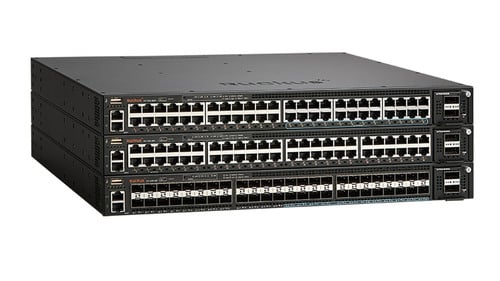In the world of networking, a 48-port switch stands out as a versatile and powerful tool for expanding and managing network infrastructure. With the increasing demand for connectivity in businesses, institutions, and data centers, a 48-port switch offers the capacity and flexibility to handle numerous devices and data traffic effectively. Let's delve into the significance of 48-port switches, their key features, benefits, and how they play a vital role in building scalable and efficient networks.
Understanding 48-Port Switches
What is a 48-Port Switch?
Switch is a network device that provides 48 Ethernet ports for
connecting various devices such as computers, servers, printers, IP phones, and
other networking equipment. These switches operate at Layer 2 or Layer 3 of the
OSI model, enabling efficient data transmission within a local area network
(LAN) or between VLANs (Virtual Local Area Networks).
Key Features of 48-Port Switches
Port Density: The primary feature of a 48-port switch is its high port density, offering 48 Ethernet ports in a single device. This allows organizations to connect a large number of devices without the need for additional switches.
Gigabit Ethernet: Most modern 48-port switches support Gigabit Ethernet (10/100/1000 Mbps) speeds on each port. This high-speed connectivity ensures fast data transfer rates for demanding applications and multimedia streaming.
PoE (Power over Ethernet): Many 48-port switches are equipped with Power over Ethernet capability, allowing them to power PoE-enabled devices such as IP cameras, wireless access points, and VoIP phones directly through the Ethernet cable. This eliminates the need for separate power sources and simplifies deployment.
Layer 3 Routing: Some 48-port switches offer Layer 3 routing capabilities, allowing them to route traffic between VLANs or subnets. This enhances network segmentation, security, and traffic management.
Management and Monitoring: 48-port switches often come with advanced management features such as web-based interfaces, SNMP (Simple Network Management Protocol) support, and VLAN configuration. These features enable administrators to monitor and manage the switch remotely.
Benefits of 48-Port Switches
Scalability
A 48-port switch provides
ample room for network expansion and growth. Organizations can easily add new
devices or expand existing network segments without running out of ports. This
scalability makes 48-port switches ideal for growing businesses and
environments with evolving connectivity needs.
Simplified Network Infrastructure
By consolidating multiple
devices onto a single 48-port switch, organizations can simplify their network
infrastructure. This reduces the need for additional switches, cables, and
power sources, leading to a more streamlined and cost-effective setup.
Improved Performance
With Gigabit Ethernet support
on all ports, 48-port switches deliver high-speed data transfer rates and low
latency. This ensures that applications and services run smoothly, providing
users with a seamless experience even during peak usage periods.
Power Efficiency
48-port switches with PoE
capability offer power efficiency by delivering both data and power over a
single Ethernet cable. This reduces the number of power outlets required and
allows for flexible placement of PoE devices without proximity to power
sources.
Enhanced Security
Layer 3 routing capabilities
in some 48-port switches enable organizations to implement advanced security
measures such as access control lists (ACLs) and VLANs. These features enhance
network segmentation, isolate traffic, and improve overall network security.
Use Cases of 48-Port Switches
Business Offices
In office environments, a
48-port switch provides connectivity for a large number of workstations,
printers, VoIP phones, and other devices. It allows for easy expansion as the
business grows and provides a centralized hub for network management.
Data Centers
Data centers require
high-density switches to connect numerous servers and storage devices. A
48-port switch with Gigabit Ethernet and PoE support is ideal for powering and
connecting a variety of equipment in a data center environment.
Educational Institutions
Schools and universities
benefit from 48-port switches to connect classrooms, labs, and administrative
areas. These switches support a wide range of devices used in educational
settings, such as computers, projectors, IP cameras, and access points.
Hospitality and Retail
In hospitality settings like
hotels and retail stores, 48-port switches provide connectivity for guest
rooms, point-of-sale (POS) systems, surveillance cameras, and Wi-Fi access
points. PoE-enabled switches simplify deployment and reduce cabling complexity.
Implementing 48-Port Switches
Assess Network Requirements
Before choosing a 48-port
switch, assess the current and future network requirements, including the
number and types of devices to be connected, data transfer speeds needed, and
PoE requirements.
Select the Right Model
Choose a 48-port switch model
that meets the specific needs of the network, such as Gigabit Ethernet support,
PoE capability, Layer 3 routing, and management features. Consider reputable
brands known for reliability and performance.
Plan for Redundancy and Uplinks
For critical networks,
consider redundancy by deploying multiple 48-port switches in a stack or using
uplink ports for connection to core switches or routers. This enhances network
reliability and provides failover capabilities.
Configure VLANs and Security Settings
Utilize the VLAN capabilities
of the 48-port switch to segment the network and improve security. Configure
access control lists (ACLs), port security, and other security features based
on best practices and organizational requirements.
Monitor and Maintain Regularly
After deployment, regularly
monitor the 48-port switch for performance, traffic patterns, and security
events. Conduct firmware updates, backups, and preventive maintenance to ensure
optimal performance and security.
Conclusion: Building Scalable and Efficient Networks with 48-Port Switches
In the ever-evolving landscape
of networking, 48-port switches serve as essential building blocks for creating
scalable, efficient, and high-performance networks. With their high port
density, Gigabit Ethernet support, PoE capabilities, and advanced management
features, these switches offer organizations the flexibility and reliability
needed to connect and manage a diverse range of devices.
For more info. visit us:





Comments